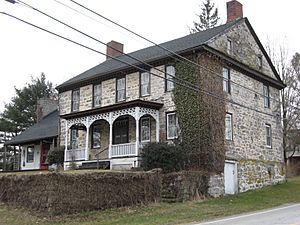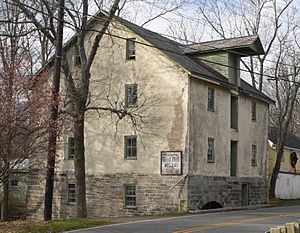Casper Shafer facts for kids
Casper Shafer (born around 1712, died 17 December 1784) was one of the first people to settle in the village of Stillwater, New Jersey. This village is located along the Paulins Kill river in Sussex County. Casper Shafer was a successful miller, meaning he operated a mill that ground grain into flour. He also owned one of the first taverns in the area. Later, during the American Revolution, Shafer served in the first meetings of the New Jersey Legislature. During this time, New Jersey became an independent state, created its first constitution, and strongly supported the Continental Army (the American army fighting for independence).
Contents
Biography
Early Life and Journey to America
Casper Shafer was born in 1712 in a region called Rhineland-Palatinate in what is now Germany. He was one of many thousands of German Palatines who left southwestern Germany in the 1700s. They were trying to escape war and poverty. These families traveled up the Rhine River to Rotterdam, a city in the Netherlands, to find a ship to the New World.
Shafer sailed to the American colonies on a ship called the Queen Elizabeth. He arrived in Philadelphia on 16 September 1738. After 1741, he married Maria Catrina Bernhardt (1722–1794). Around 1742, Casper Shafer, his father-in-law, and his brother-in-law, along with their families, settled along the Paulins Kill river in northwestern New Jersey. Over the next few decades, more German families joined them, and this settlement grew into the village of Stillwater.
Life in New Jersey
When they first arrived, life was very simple. The settlers shared a log cabin, and a large tree stump even served as their family table! Casper Shafer and Maria Catrina had four children, all born in Stillwater: Peter (1744–1799), Margaretta (1745–1815), Abraham (1754–1820), and Isaac (1760–1800).
A few years after settling, Shafer built a simple grist mill along the Paulins Kill. This first mill could grind about three to five bushels of flour each day. Later, in 1764, he built a much larger mill. He also built a saw mill, an oil-mill, and a tannery (a place to make leather). To help with the hard work on the farm and at the mill, Casper Shafer had people assist him. In those days, it was common for wealthy landowners to have people, often African Americans, who were forced to work for them. Shafer also planted large apple orchards on his land in Stillwater. Some of these apple trees grew to be very large, with trunks over three feet wide!
When Sussex County was formed in 1753, Casper Shafer and a few other early settlers were given licenses to open taverns. Each year, Shafer would travel down the Paulins Kill and Delaware River by flatboat. He would take flour and other farm products to the market in Philadelphia. On his way back, he would bring goods that the settlers needed.
For many years, Shafer didn't know about the English cities along Newark Bay. The local Munsee people (a group of Lenape Native Americans) told him about a town they called Lispatone, which was actually Elizabethtown (now Elizabeth, New Jersey). Shafer had never heard of it! He traveled about fifty miles over mountains and through the wilderness to find this town. There, he started trading his goods. This helped open up important trade routes between the southeastern coast and northwestern New Jersey. Later, in 1756-1757, a military supply road was built during the French and Indian War. This road connected Elizabeth and Morristown with the frontier.
In 1775, Shafer became a member of the Committee of Safety for Sussex County. This committee was in charge of raising money to buy weapons and supplies for the province. The next year, Shafer and two other men represented Sussex County in the Provincial Congress of New Jersey. This important meeting began in Burlington on 10 June 1776. During this time, New Jersey became an independent state, removed and imprisoned the Royal Governor, William Franklin, and created its first constitution.
In August, the Provincial Congress met in Princeton and became the state's first Legislature. It is said that Shafer would sometimes stand up and exclaim in German, "Das ist nicht recht! Das ist nicht recht!" (which means "That is not right! That is not right!") before explaining his point in English. He represented the county for the next three years. He was known for always attending meetings and voting for strong actions to help win the war.
Death and Legacy
Casper Shafer passed away on 7 February 1784 in Stillwater. He had some disagreements with the local German church leaders about their beliefs. In his later years, he became good friends with a Presbyterian minister named Rev. Ira Condict. Condict later became the President of Queen's College (which is now Rutgers University).
Shafer asked Condict to lead his burial service. However, the German church leaders did not want Condict to use their church building. So, Condict gave a speech about Shafer from the church's front steps. Casper Shafer was buried in the churchyard at Stillwater. His tombstone reads:
C. S.
In memory of
Casper Shaver, who
departed this life Dec.
the 7th, 1784, in the 72
year of his age.
On 10 December 2009, the grist mill that Casper Shafer built (and which his son Abraham later operated) was added to the state and National Register of Historic Places. This historic site is now cared for by the Ridge and Valley Conservancy, a group that works to protect the local environment and preserve history. The mill is often open for visitors and educational events.
Images for kids
-
Casper Shafer's house in Stillwater, New Jersey—the log cabin portion of the structure (left) was built circa 1742, the main stone section (right) circa 1750. The architecture is typical of colonial-era and early American houses built by the Palatine German emigrants who settled in the Paulins Kill valley.







